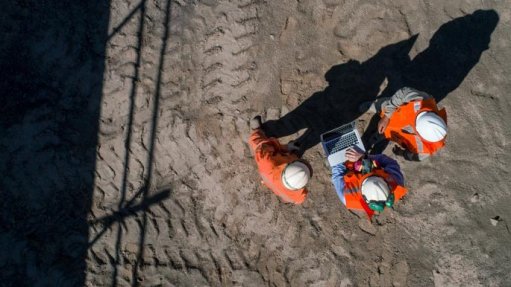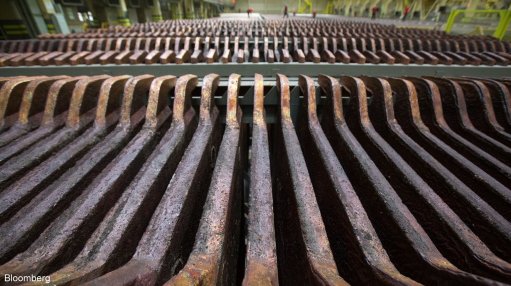Mine migrant labour reform being ‘workshopped’ – Teba
JOHANNESBURG (miningweekly.com) – A migrant labour reform project, which could see the implementation of a new system of affording migrant mineworkers more time at home with their families, was at an advanced stage of “workshopping”, Teba Limited top brass said on Thursday.
Responding to Mining Weekly Online during question time at the Junior Mining & Exploration Conference in Bryanston, Teba executive chairperson and labour union pioneer Dr James Motlatsi revealed that Teba was conducting the project with JSE-listed gold-mining company Sibanye Gold to arrive at a new shift system.
“We’ve got a workshop with Sibanye, looking at an arrangement of four months on and two months off,” Teba MD Graham Herbert added to Mining Weekly Online.
The current system is one of 11-shift fortnights and 12 days holiday a year and the new system being workshopped involves working for eight months of the year and being at home for four months.
Sibanye, headed by CEO Neal Froneman, operates the Kloof and Driefontein gold mines in the West Witwatersrand region and Beatrix gold mine in the Free State.
The company has 35 000 employees, most of them migrant mineworkers.
With gold reserves of 13.5-million ounces and resources of 74.2-million ounces, Sibanye has the potential to produce more than 1.2-million ounces of gold a year for more than ten years, according to its website.
Motlatsi, the founding president of the National Union of Mineworkers (NUM), told the conference that while the South African mining industry had problems, there were also solutions.
Teba, which recruited him to work in the mining industry in 1970 and which he at one stage hated with a passion, serves mines and mineworkers in mining communities, as well as within their rural communities, before, during and after employment.
Motlatsi has been playing a role in addressing the burning migrant-labour issue, a legacy factor in an industry that directly employs 500 000 people and which outgoing Chamber of Mines of South Africa president Mark Cutifani said on Tuesday benefited the lives of eight out of every ten South Africans “directly and literally”.
“In the end, we are an industry for the people,” Cutifani told the chamber’s 123rd annual general meeting.
Motlatsi made it clear that the number of migrant mineworkers in South Africa was too substantial for local mining companies to be able to emulate the kind of global best practice dispensed in other countries like Australia and Argentina, which included fly-in, fly-out arrangements.
The former AngloGold Ashanti deputy chairperson and current Shanduka nonexecutive director, who began his working life as a 40c-a-shift mine labourer, emphasised that the current situation should not be viewed as either a labour or a management problem, but as an industry problem.
“You can’t do away with migrant labour overnight. My suggestion is for migrant mineworkers to work for four months and go home for two months,” Motlatsi reiterated to Mining Weekly Online.
The new work arrangement has the potential to improve the economies of the rural areas and increase employment opportunities on mines, without significantly increasing the cost to mining companies.
At the same time, those mineworkers willing to leave the rural areas and relocate with their rural families to near-mine environments should be accommodated.
“You must have shift arrangements to allow these people to work enough time at the mine and then to go home and stay for enough time for them to do something at home. I think that is the best way to do it,” he said.
He advised against negotiation of new shifts as part of wage talks and suggested an analysis of the labour force to discover the level of family accommodation that should be targeted close to mines.
The current project with Sibanye was giving Teba insight into the efficacy of new shift arrangements.
“There are those who say they don’t want to recruit people from Lusikisiki [in the Eastern Cape] for mines that are in Limpopo. They are making a terrible mistake. Those minerals don’t belong to Limpopo but to the nation as a whole.
"There is no area where you would be able to have all the skills. The mines need to deal with the local government where there are located for [the provision of] reconstruction and development programme (RDP) houses for mineworkers willing to migrate to the mining towns, because it’s not everyone who wants to live in mining towns," Motlatsi said.
Mines needed to deal with local governments for RDP houses for those willing to leave rural areas and, separately, with those who qualified for their own housing bonds.
Further, rental accommodation needed to be provided for those who did not want to leave the rural labour-sending areas.
On living-out allowances, Motlatsi said these should be paid directly to the providers of miners’ accommodation and not to the miners themselves.
“The migrant labour system is a structural problem. In order to deal with it you must have short-, medium- and long-term plans that involve everybody. Then we’ll create a climate that will be conducive to investors to invest in mining,” he said.
The leadership of NUM and the Association of Mineworkers and Construction Union should cease attacking one another as lives are at stake and they should discuss the drawing up a memorandum of understanding on the issue of service delivery to mineworkers.
Industrial sociologist Gavin Hartford last year placed the migrant labour system at the heart of South Africa’s mining unrest, saying that its punishing yearly work cycle spawned social evils.
The Esop Shop CEO proposed that a new migratory labour model be founded on human dignity and shorter work cycles, within a continuous-operation scenario.
South African Institute of Mining and Metallurgy president Dr Gordon Smith, writing in the institute journal, said the migrant-labour issue had moved beyond being an industry issue alone and was now part of the fabric of life in South Africa as a whole.
Smith advocated that it be changed progressively and in a way that did not worsen poverty levels in the rural areas from which the labour was being sent.
Under discussion at the junior mining conference was the revised social and labour plan of the Department of Mineral Resources to address challenges in the aftermath of last year's Marikana killings in Rustenburg's platinum belt.
Comments
Press Office
Announcements
What's On
Subscribe to improve your user experience...
Option 1 (equivalent of R125 a month):
Receive a weekly copy of Creamer Media's Engineering News & Mining Weekly magazine
(print copy for those in South Africa and e-magazine for those outside of South Africa)
Receive daily email newsletters
Access to full search results
Access archive of magazine back copies
Access to Projects in Progress
Access to ONE Research Report of your choice in PDF format
Option 2 (equivalent of R375 a month):
All benefits from Option 1
PLUS
Access to Creamer Media's Research Channel Africa for ALL Research Reports, in PDF format, on various industrial and mining sectors
including Electricity; Water; Energy Transition; Hydrogen; Roads, Rail and Ports; Coal; Gold; Platinum; Battery Metals; etc.
Already a subscriber?
Forgotten your password?
Receive weekly copy of Creamer Media's Engineering News & Mining Weekly magazine (print copy for those in South Africa and e-magazine for those outside of South Africa)
➕
Recieve daily email newsletters
➕
Access to full search results
➕
Access archive of magazine back copies
➕
Access to Projects in Progress
➕
Access to ONE Research Report of your choice in PDF format
RESEARCH CHANNEL AFRICA
R4500 (equivalent of R375 a month)
SUBSCRIBEAll benefits from Option 1
➕
Access to Creamer Media's Research Channel Africa for ALL Research Reports on various industrial and mining sectors, in PDF format, including on:
Electricity
➕
Water
➕
Energy Transition
➕
Hydrogen
➕
Roads, Rail and Ports
➕
Coal
➕
Gold
➕
Platinum
➕
Battery Metals
➕
etc.
Receive all benefits from Option 1 or Option 2 delivered to numerous people at your company
➕
Multiple User names and Passwords for simultaneous log-ins
➕
Intranet integration access to all in your organisation


















